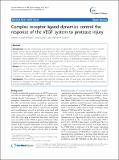| dc.contributor.author | Forsten-Williams, Kimberly | |
| dc.contributor.author | Kurtagic, Elma | |
| dc.contributor.author | Nugent, Matthew A. | |
| dc.date.accessioned | 2012-02-10T15:15:05Z | |
| dc.date.available | 2012-02-10T15:15:05Z | |
| dc.date.issued | 2011-10 | |
| dc.date.submitted | 2011-05 | |
| dc.identifier.issn | 1752-0509 | |
| dc.identifier.uri | http://hdl.handle.net/1721.1/69072 | |
| dc.description.abstract | Background Vascular homeostasis and response to injury are dependent on the coordinated activity of growth factors such as vascular endothelial growth factor-A (VEGF). VEGF signaling is mediated by VEGF receptors 1 (VEGFR1) and 2 (VEGFR2). VEGF also binds to extracellular matrix (ECM) and neuropilin (NP), a cell surface glycoprotein that enhances VEGF binding to VEGFR2 while inhibiting VEGF-VEGFR1 interactions. Proteases such as neutrophil elastase release VEGF bound to ECM; however, this results in proteolytic processing of VEGF to a smaller species termed VEGF fragment (VEGFf). We hypothesized that the generation and presence of VEGFf would have significant effects on the binding distribution of VEGF. Results We show that VEGFf, unlike VEGF, does not bind ECM, fibronectin, or NP-1. Using computational simulations, we find that excess VEGFf can lead to increased binding of VEGF to VEGFR2 through VEGFf binding to VEGFR1 and subsequent liberation of NP-1. We show experimentally that VEGF-induced migration has a biphasic response to conversion of VEGF to VEGFf. Simulations suggest that a simple change in VEGFR1 or VEGFR2 complexes are unlikely to be responsible and that a more complex integration of signals is more likely involved. Conclusions These findings suggest that proteolytic damage at sites of tissue injury and inflammation has the potential to modulate the VEGF system through a complex process and highlight the need for quantitative analysis to reveal mechanisms of growth factor control. | en_US |
| dc.description.sponsorship | National Institutes of Health (U.S.) (NIH grant HL088572) | en_US |
| dc.description.sponsorship | Massachusetts Lions Eye Research Fund, Inc. | en_US |
| dc.publisher | BioMed Central Ltd | en_US |
| dc.relation.isversionof | http://dx.doi.org/10.1186/1752-0509-5-170 | en_US |
| dc.rights | Creative Commons Attribution | en_US |
| dc.rights.uri | http://creativecommons.org/licenses/by/2.0 | en_US |
| dc.source | BioMed Central Ltd | en_US |
| dc.title | Complex receptor-ligand dynamics control the response of the VEGF system to protease injury | en_US |
| dc.type | Article | en_US |
| dc.identifier.citation | Forsten-Williams, Kimberly, Elma Kurtagic and Matthew A. Nugent. "Complex receptor-ligand dynamics control the response of the VEGF system to protease injury." BMC Systems Biology. 2011 Oct 21;5(1):170. | en_US |
| dc.contributor.department | Harvard University--MIT Division of Health Sciences and Technology | en_US |
| dc.contributor.department | Massachusetts Institute of Technology. Department of Biological Engineering | en_US |
| dc.contributor.mitauthor | Kurtagic, Elma | |
| dc.contributor.mitauthor | Nugent, Matthew A. | |
| dc.relation.journal | BMC Systems Biology | en_US |
| dc.eprint.version | Final published version | en_US |
| dc.type.uri | http://purl.org/eprint/type/JournalArticle | en_US |
| eprint.status | http://purl.org/eprint/status/PeerReviewed | en_US |
| dc.date.updated | 2012-01-09T16:08:41Z | |
| dc.language.rfc3066 | en | |
| dc.rights.holder | Forsten-Williams et al.; licensee BioMed Central Ltd. | |
| dspace.orderedauthors | Forsten-Williams, Kimberly; Kurtagic, Elma; Nugent, Matthew A | en |
| mit.license | PUBLISHER_CC | en_US |
| mit.metadata.status | Complete | |
